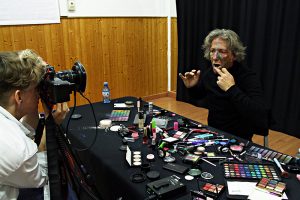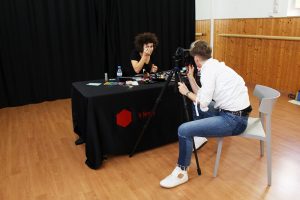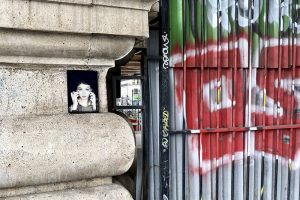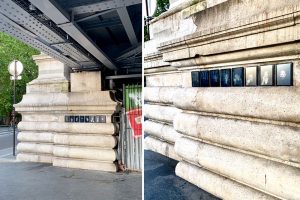De afuera dentro, ID-Identity – DECLARACIÓN DE LA ARTISTA
EL FUTURO DECIDIRÁ
ID-Identity es un proyecto que usa maquillaje para crear una ventana desde la que se muestra el interior de cada persona desde fuera. Se trata de un proyecto íntimo que juega con la psicología, el ánimo y los sentimientos de cada persona fotografiada. El montaje consta de dos sillas, una frente a la otra. Están a menos de un metro de distancia. Lo único que las separa es una pequeña mesa con productos de maquillaje. Los productos de maquillaje los usan todos los participantes y se limpian con regularidad, pero nunca durante las sesiones de retratos cuando una persona sigue a otra. Distintas personas emplean los mismos colores; un mismo pintalabios toca diversas pieles; un cepillo de rímel se emplea varias veces en diferentes pestañas; y las esponjas de maquillaje están impregnadas de crema con color de participantes anteriores. A menudo, al empezar explico detalladamente el proyecto a la persona que se sienta frente a mí y, al terminar, algunas veces doy un abrazo al voluntario de ID-Identity. Se trata de un sentimiento liberador, agradable y amistoso que siempre se disfruta a ambos lados de la cámara. Nunca pensé que todo lo descrito más arriba llegaría a resultar un problema algún día. Pero ha sucedido; hoy en día, una sesión de fotos de ID-Identity es un problema en este nuevo mundo de distancia de desinfección, y las mascarillas son un molesto intruso para mi proyecto.
Independientemente de dónde me ha llevado mi proyecto ID-Identity, siempre me han presentado a muchas personas diferentes en un corto periodo de tiempo. Nos conocíamos, trabajábamos juntos, cenábamos. Daba charlas y debatía con desconocidos. Para llevar a cabo mi proyecto, viajaba a un nuevo destino en tren o en avión, estrechaba manos, me colocaba entre una multitud de espectadores y preparaba mis dos sillas, la mesa, el maquillaje y mi cámara para presenciar y registrar cómo se maquilla la gente sin un espejo. Luego me marchaba a un lugar nuevo. Y así sucedió en Málaga en noviembre de 2018, cuando Patrícia Soley-Beltran me invitó a celebrar un taller de ID-Identity para La Térmica, un año y unos pocos meses antes de nuestra nueva realidad de distanciamiento social.
Estuve 55 días confinada en el centro de París. Mi piso se encuentra muy cerca de una de las estaciones de tren más grandes de Europa. Vivo en un barrio muy bullicioso durante todo el año. Y, de pronto, ¡nada! Sin gente. Sin tumulto. Sin ruido en la calle. Sin diversión. Solo se oían las sirenas de las ambulancias que atravesaban las calles. Eso me hizo plantearme una y otra vez dudas sobre cómo nos cambiaría el confinamiento. ¿Qué pasará con el mundo después de este encierro? ¿Cómo cambiará el negocio del arte? ¿Cómo cambiará la economía? ¿Cómo cambiará nuestro comportamiento social? ¿Cómo cambiará el racismo? ¡Cómo no cambiará el racismo! ¿Cómo mantener el contacto sin contacto?
Tras un mes entero encerrada mirando al exterior, comencé a colgar algunas de mis obras de arte en el muro de mi edificio y decidí que la galería era ese mismo muro. Una zona en obras puede ser una galería, un parque de patinaje puede ser una galería, una valla puede ser una galería y, por supuesto, un espacio virtual puede ser una galería. Me di cuenta de que la manera en que vivía y trabajaba había desaparecido y que debía replantearme y reinventar mi proceso creativo teniendo en cuenta la seguridad de las personas implicadas para mantener la sostenibilidad necesaria para mi crecimiento artístico y personal.
Tenía muchas ganas de contactar con los participantes de ID-Identity en Málaga porque España se vio gravemente afectada y quería saber si todo el mundo estaba bien. La devastadora realidad fue que Salomé nos dejó el pasado mes de mayo. Esta exposición está dedicada a ella y alberga la promesa de que, independientemente de que las obras de ID-Identity se muestren en una sala de exposiciones o un espacio virtual, la pared de una galería o la de un edificio en plena calle, se mostrarán una y otra vez, con distancia de seguridad o en una sala abarrotada. El futuro decidirá.
Susanne Junker, agosto de 2020
SOBRE LA ARTISTA
Susanne Junker es una artista autodidacta cuyo trabajo se centra en la fotografía, específicamente en la identidad y la feminidad. Nacida en Alemania en 1973, trabaja y vive en Paris. Autoobservándose desde niña, Junker utiliza su propio cuerpo como tela para la interpretación de temas sociales y comportamiento femenino. Como cotizada modelo en los 90, Susanne Junker inició una serie de autorretratos y se convierte simultáneamente en sujeto y autora. Utilizó su exposición mediática como modelo para romper con las preconcepciones que rodean el trabajo de maniquí desde una perspectiva feminista.
Desde primeros de 2000, Junker ha creado proyectos como “Supermodels?”, “the perfect woman is a lie”, “figures for the base of a crucifixion”, “ID-Identity” and “self-doll”, entre otros, en los que reflexiona sobre la identificación de género, la objetificación de las mujeres y el uso de la sexualidad en los medios de comunicación de masas mediante la fotografía, el vídeo, el dibujo y la performance.
En 2008, Junker fundó stage 候台BACK, un espacio autogestionado por artistas en Shanghai China que dirigió del 2008 al 2013. En 2017 publicó el libro 21st CENTURY WOMAN, editado por el Journal Of Culture, Leipzig. En 2018 Junker fue seleccionada por el Goethe Institut de Shanghai y el Shanghai Institute of Design como artista residente en la China Academy of Art. En tiempos en los que todo el mundo en las redes sociales se autodenomina artista, Junker rehusa ser categorizada como ‘mujer artista’. Ella misma creó el hashtag #femaleartisthashtagsucks y reivindica “¡no soy una artista! ¡Soy Susanne Junker, artista!”
Inside Outside You Me,
ID-Identity – ARTIST STATEMENT
FUTURE WILL DECIDE
ID-Identity uses make-up to create a window to show the inside of individual people outside. It is an intimate project and plays with your psyche, moods and feelings while being photographed. The set-up is two chairs facing each other. They are less then one meter apart. Only a small table that is covered with make-up products separates them. The make-up products are used by all the contestants and cleaned regularly but never during the portrait sessions when one person follows after another. Different people use the same colors, one lipstick touches various skins, a mascara brush is used multiple times on many lashes and make-up sponges are soaked with colored cream from previous participants. Often, at start I am explaining the project closely to my opposite and when finished, I sometimes hug my ID-Identity volunteer. It’s a releasing affection, sweet and friendly that was always enjoyable for both sides of the camera. I’d never thought that the all above described would be problematic one day. But it happened, today an ID-Identity photo session is an issue in our new world of disinfecting distance and a face mask is a disturbing intruder for my project.
It doesn’t matter where ID-Identity brought me, I always got introduced to many different people in a short period of time. We met, worked together, had dinner. I gave talks and had discussions with strangers. I’d travel to a new destination in a train or a plane for my project, shook hands, stood in a crowd of spectators and after all set up my two chairs, table and make-up and my camera to witness and record how people color themselves without a mirror. And then I left to a new place. And so it was in Málaga in November 2018 when Patrícia Soley-Beltran invited me to host an ID-Identity workshop for La Térmica, a year and a few months away from our new world of social distance.
I was confined fifty-five days in downtown Paris. My apartment is located close to one of the biggest train stations in Europe. My neighborhood is extremely busy all year long. And then, nothing! No people. No crowds. No street noise. No diversion. Except of the ambulance sirens blasting through the streets that drew me to the hammering questions of how the confinement will change us? What will happen in this world after the lock down? How it will change the art business? How it will change the economy? How it will change our social behavior? How it will change racism? How won’t it change racism! How to be and stay in touch without the touch?
After one solid month of being inside looking outside, I started hanging some of my art works on my building wall and decided that the gallery is the wall where I am. A construction site can be a gallery, a skate park can be a gallery, a fence can be a gallery and furthermore a virtual space can be a gallery. I realized that the way I lived and worked has vanished and my way of creating must be revisited and reinvented while caring about the people I included to maintain the sustainability that is necessary for my artistic and personal growth.
I dearly wanted to get in touch with ID-Identity participants in Málaga since Spain was so drastically hit to just simply know if everybody was alright. And the devastating reality is that Salomé left us last May. This exhibition is dedicated to her with the promise that whether the ID-Identity works are shown in a exhibition hall or a virtual space, a gallery wall or a building wall on the street, they will get shown again and again, within disinfecting distance or in a crowded room. The future will decide.
Susanne Junker, August 2020
ABOUT THE ARTIST
Susanne Junker is a self-taught artist whose work focuses on photography, specifically on identity and femininity. Born in Germany in 1973, she works and lives in Paris. Junker has practised self-observation since early childhood, and now uses her own body as a canvas for the interpretation of social issues and female behaviour. While still a sought-after model in the 1990s, Susanne Junker initiated a series of self-portraits and became both subject and author at the same time. She used her media exposure as a model to break down the preconceptions surrounding modelling work from a feminist perspective.
Since early 2000s, Junker has created projects such as «Supermodels?», «The perfect woman is a lie», «Figures for the base of a crucifixion», «ID-Identity» and «Self-doll», among others, in which she reflects on gender identification, the objectification of women and the use of sexuality in the mass media through photography, video, drawing and performance.
In 2008, Junker founded stage 候台BACK, a self-managed space for artists in Shanghai China that she directed from 2008 to 2013. In 2017, she published the book 21st CENTURY WOMAN, edited by the Journal Of Culture, Leipzig. In 2018, Junker was selected by the Goethe Institute in Shanghai and the Shanghai Institute of Design as an artist in residence at the China Academy of Art.
In times when everyone on social media claims to be an artist, Junker refuses to be categorised as ‘female artist’. She invented the hashtag #femaleartisthashtagsucks and claims “I am not an artist! I am Susanne Junker, artist!”.
More at http://www.susannejunker.com/




